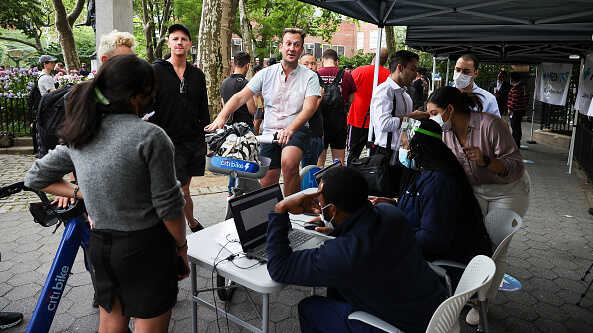Monkeypox outbreak in U.S. is bigger than the CDC reports : Shots

People line up outside of the New York City Department of Health and Mental Hygiene on June 23, as the city makes vaccines available to residents possibly exposed to monkeypox.
Tayfun Coskun/Anadolu Agency via Getty Images
hide caption
toggle caption
Tayfun Coskun/Anadolu Agency via Getty Images

People line up outside of the New York City Department of Health and Mental Hygiene on June 23, as the city makes vaccines available to residents possibly exposed to monkeypox.
Tayfun Coskun/Anadolu Agency via Getty Images
On June 13, a man in New York began to feel ill.
“He starts to experience swollen lymph nodes and rectal discomfort,” says epidemiologist Keletso Makofane, who’s at Harvard University.
The man suspects he might have monkeypox. He’s a scientist, and knowledgeable about the signs and symptoms, Makofane says. So the man goes to his doctor and asks for a monkeypox test. The doctor decides, instead, to test the man for common sexually transmitted diseases. All those come back negative.
“A few days later, the pain worsens,” Makofane says. So he goes to the urgent care and again asks for a monkeypox test. This time, the provider prescribes him antibiotics for a bacterial infection.
“The pain becomes so bad, and starts to interfere with his sleep,” Makofane says. “So this past Sunday, he goes to the emergency room of a big academic hospital in New York.”
At this point the man has a growth inside his rectum, which is a symptom of monkeypox. At the hospital, he sees both an ER doctor and an infectious disease specialist. Again, the man asks for a monkeypox test. But the specialist rebuffs the request and says “a monkeypox test isn’t indicated,” Makofane says. Instead, the doctor speculates that the man might have colon cancer.
A few days later, he develops skin lesions — another key sign of monkeypox.
A misleading case count
On the surface, the monkeypox outbreak in the U.S. doesn’t look that bad, especially compared with other countries. Since the international epidemic began in May, the U.S. has recorded 201 cases of monkeypox. In contrast, the U.K. has nearly 800 cases. Spain and Germany both have more than 500.
But in the U.S., the official case count is misleading, Makofane and other scientists tell NPR. The outbreak is bigger — perhaps much bigger — than the case count suggests.
For many of the confirmed cases, health officials don’t know how the person caught the virus. Those infected haven’t traveled or come into contact with another infected person. That means the virus is spreading in some communities and cities, cryptically.
“The fact that we can’t reconstruct the transmission chain means that we are likely missing a lot of links in that chain,” Jennifer Nuzzo, an epidemiologist at Brown University, says. “And that means that those infected people haven’t had the opportunity to receive medicines to help them recover faster and not develop severe symptoms.
“But it also means that they’re possibly spreading the virus without knowledge of the fact that they’re infected,” she adds.
In other words: “We have no concept of the scale of the monkeypox outbreak in the U.S.,” says biologist Joseph Osmundson at New York University. “
Why are so few cases getting detected? Testing. In many ways, the U.S. has dropped the ball on monkeypox testing.
Across the nation, public health agencies are running too few tests — way too few, Osmundson says. “State officials are denying people testing because they’re using a narrow definition of monkeypox to decide who receives a test. They’re testing in only a very restrictive number of cases.”
Take for instance the man Makofane knows. Eventually, after seeing more than four doctors, the man finally finds an activist who’s trying to expand testing. The activist connects the man with a doctor who orders a test through a private company (that’s working to produce a commercial test.) The result: He’s positive. He has monkeypox.
Makofane says the testing situation right now is so “abysmal” in the U.S. that he launched his own study, called RESPND-MI, to figure out the prevalence of monkeypox in New York City and to help friends share information about monkepox.
The CDC would not divulge to NPR how many tests have been performed across the country, nor will the agency say where community transmission is likely occurring in the U.S. (NPR emailed the agency multiple times about these questions but the…
Read More: Monkeypox outbreak in U.S. is bigger than the CDC reports : Shots

